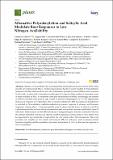Por favor, use este identificador para citar o enlazar a este item:
http://hdl.handle.net/10261/344741COMPARTIR / EXPORTAR:
 SHARE SHARE
 CORE
BASE CORE
BASE
|
|
| Visualizar otros formatos: MARC | Dublin Core | RDF | ORE | MODS | METS | DIDL | DATACITE | |

| Título: | Alternative Polyadenylation and Salicylic Acid Modulate Root Responses to Low Nitrogen Availability |
Autor: | Conesa, Carlos M.; Saez, Angela; Navarro Neila, Sara; de Lorenzo, L.; Hunt, Arthur G.; Sepúlveda, Edgar B.; Baigorri, R.; Garcia-Mina, J. M.; Zamarreño, Angel M.; Sacristán, Soledad; del Pozo, J. C. | Palabras clave: | Alternative polyadenylation Nitrogen starvation Root development Salicylic acid |
Fecha de publicación: | 16-feb-2020 | Editor: | Multidisciplinary Digital Publishing Institute | Citación: | Plants 9(2): e251 (2020) | Resumen: | Nitrogen (N) is probably the most important macronutrient and its scarcity limits plant growth, development and fitness. N starvation response has been largely studied by transcriptomic analyses, but little is known about the role of alternative polyadenylation (APA) in such response. In this work, we show that N starvation modifies poly(A) usage in a large number of transcripts, some of them mediated by FIP1, a component of the polyadenylation machinery. Interestingly, the number of mRNAs isoforms with poly(A) tags located in protein-coding regions or 5'-UTRs significantly increases in response to N starvation. The set of genes affected by APA in response to N deficiency is enriched in N-metabolism, oxidation-reduction processes, response to stresses, and hormone responses, among others. A hormone profile analysis shows that the levels of salicylic acid (SA), a phytohormone that reduces nitrate accumulation and root growth, increase significantly upon N starvation. Meta-analyses of APA-affected and fip1-2-deregulated genes indicate a connection between the nitrogen starvation response and salicylic acid (SA) signaling. Genetic analyses show that SA may be important for preventing the overgrowth of the root system in low N environments. This work provides new insights on how plants interconnect different pathways, such as defense-related hormonal signaling and the regulation of genomic information by APA, to fine-tune the response to low N availability. | Descripción: | 16 Pág. | Versión del editor: | https://doi.org/10.3390/plants9020251 | URI: | http://hdl.handle.net/10261/344741 | DOI: | 10.3390/plants9020251 | E-ISSN: | 2223-7747 |
| Aparece en las colecciones: | (INIA) Artículos |
Ficheros en este ítem:
| Fichero | Descripción | Tamaño | Formato | |
|---|---|---|---|---|
| Alternative Polyadenylation.pdf | artículo | 2,48 MB | Adobe PDF |  Visualizar/Abrir |
CORE Recommender
PubMed Central
Citations
10
checked on 11-may-2024
SCOPUSTM
Citations
23
checked on 14-may-2024
WEB OF SCIENCETM
Citations
20
checked on 23-feb-2024
Page view(s)
18
checked on 15-may-2024
Download(s)
2
checked on 15-may-2024

